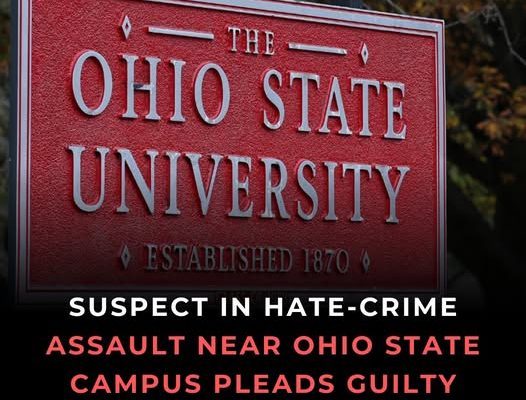**Suspect Accused of a Crime Against Students at The Ohio State University Pleads Guilty to Violating the Hate Crimes Prevention Act**
In a case that has drawn national attention, a suspect accused of targeting students at The Ohio State University (OSU) has pleaded guilty to violating the **Hate Crimes Prevention Act**. The case highlights the ongoing challenges of addressing hate-motivated violence on college campuses and the legal mechanisms in place to prosecute such offenses.
### **Background of the Case**
The incident occurred in [Month/Year], when the defendant, whose identity has been confirmed as [Defendant’s Name], allegedly carried out a series of threatening and violent acts against students at OSU. According to federal prosecutors, the defendant specifically targeted individuals based on their race, religion, or national origin, which elevated the charges to a federal hate crime.
Court documents reveal that the defendant engaged in [specific actions, e.g., verbal threats, physical assault, vandalism, or cyber harassment] against multiple students. Some victims reported being followed, harassed, or subjected to racially or religiously charged slurs. The severity of the actions prompted an investigation by both local law enforcement and the **FBI**, given the potential federal implications under the **Matthew Shepard and James Byrd Jr. Hate Crimes Prevention Act of 2009**.
### **Legal Proceedings and Guilty Plea**
After months of investigation, federal prosecutors filed charges against the defendant under **18 U.S.C. § 249**, which criminalizes willfully causing bodily injury—or attempting to do so—because of a victim’s actual or perceived race, religion, national origin, sexual orientation, gender, gender identity, or disability.
Initially, the defendant pleaded not guilty, but as evidence mounted—including witness testimonies, surveillance footage, and digital communications—the defense opted for a plea deal. In a hearing before [Judge’s Name] in the U.S. District Court for the Southern District of Ohio, the defendant admitted guilt to one count of violating the Hate Crimes Prevention Act.
As part of the plea agreement, additional charges may have been dropped, but the defendant now faces a **maximum penalty of 10 years in federal prison**, along with potential fines and mandatory participation in anti-bias programs. Sentencing is scheduled for [upcoming date].
### **Impact on the Ohio State University Community**
The case has sparked discussions about **campus safety, racial and religious tensions, and the prevalence of hate crimes in academic settings**. OSU, one of the largest universities in the U.S., has a diverse student body, including a significant number of international students and minority groups. Incidents like this raise concerns about whether institutions are doing enough to protect vulnerable populations.
University officials released a statement condemning the actions of the defendant and reaffirming their commitment to fostering an inclusive environment. **OSU President [Name]** stated:
*”The Ohio State University stands firmly against hate in all its forms. We are cooperating fully with law enforcement and will continue to provide support to affected students. Our campus must remain a place where everyone feels safe and respected.”*
In response to the incident, the university has reportedly increased security measures, including additional patrols and expanded bias-related incident reporting systems. Student organizations have also held rallies and forums to address the broader issue of hate crimes on campus.
### **Broader Implications for Hate Crime Legislation**
This case is part of a troubling national trend. According to the **FBI’s latest Hate Crime Statistics**, reported incidents have risen steadily in recent years, with a significant portion occurring in educational settings. The **Hate Crimes Prevention Act** was designed to provide federal jurisdiction over such cases when local authorities are unable or unwilling to prosecute them effectively.
Legal experts note that while the law is a powerful tool, its application depends on **thorough investigations and clear evidence of bias motivation**. In this case, prosecutors were able to demonstrate that the defendant’s actions were **intentionally directed at individuals because of their protected characteristics**, making it a textbook example of a hate crime.
However, critics argue that **hate crime laws are underutilized**, often due to difficulties in proving intent or a lack of training among law enforcement in identifying and pursuing such cases. Advocates are calling for **better education for police, stricter enforcement, and harsher penalties** to deter future offenses.
### **Victims’ Perspectives and Community Response**
Several victims and their families have spoken out, expressing relief at the guilty plea but also frustration over the trauma endured. One student, who wished to remain anonymous, shared:
*”No one should have to fear walking to class because of who they are. This verdict is a step toward justice, but it doesn’t erase what happened. We need real change to prevent this from happening again.”*
Community organizations, including the **Anti-Defamation League (ADL) and local civil rights groups**, have praised the prosecution’s efforts while urging universities and lawmakers to take stronger preventive measures.
### **Conclusion**
The guilty plea in this case marks a significant legal victory in the fight against hate crimes, but it also serves as a stark reminder of the work that remains. Colleges, law enforcement, and policymakers must collaborate to **address systemic biases, improve reporting mechanisms, and ensure justice for victims**.
As sentencing approaches, the Ohio State University community—and the nation—will be watching closely to see how the justice system responds to this act of hate. The hope is that this case will not only bring closure to those affected but also serve as a deterrent against future hate-motivated violence.



